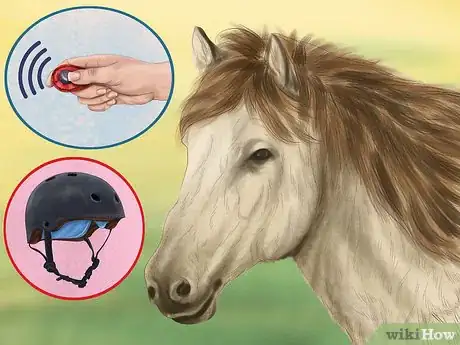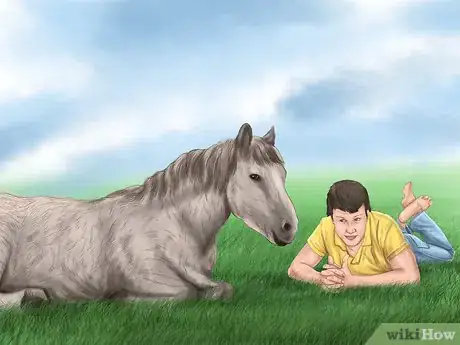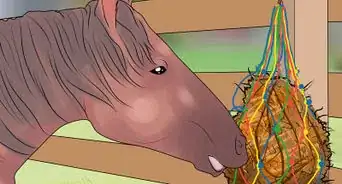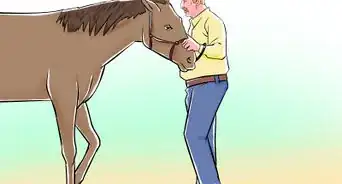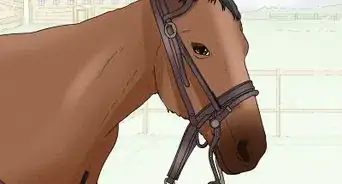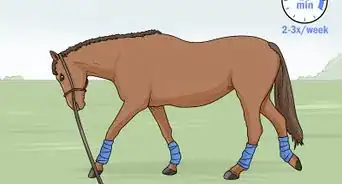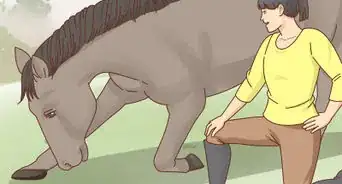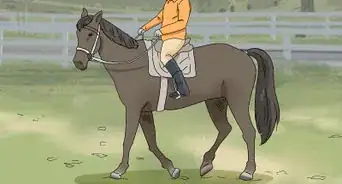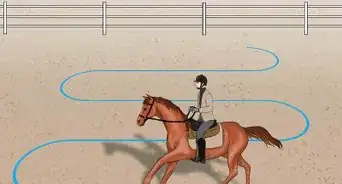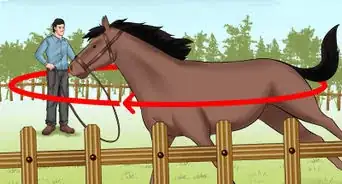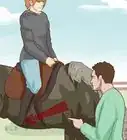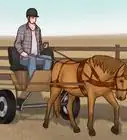This article was co-authored by Pippa Elliott, MRCVS. Dr. Elliott, BVMS, MRCVS is a veterinarian with over 30 years of experience in veterinary surgery and companion animal practice. She graduated from the University of Glasgow in 1987 with a degree in veterinary medicine and surgery. She has worked at the same animal clinic in her hometown for over 20 years.
This article has been viewed 192,550 times.
Training a horse, in general, requires patience. Training a horse to lie down also requires trust. Your horse has to trust you because he’s putting himself in a very vulnerable position by lying down in front of you. Historically, lying down a horse has also been used to train uncooperative horses by purposefully putting them into a vulnerable position in order to teach them who is in charge. While some horse trainers and wranglers may still use this controversial method, it will not be explained here. Instead, this article will outline two safe and humane methods to teach a horse to lie down. Both methods allow the horse to lie down on his own, when he’s ready and willing.
Steps
Training Behaviour with a Clicker
-
1Bring the required equipment with you. To train a horse using a clicker, you’ll need to (obviously) bring the horse and clicker with you, but you’ll also need your horse’s favourite treats. Plus, for safety purposes, you should wear the proper equipment yourself so you don’t get hurt if the horse gets spooked.[1]
- A helmet is always an excellent piece of safety equipment to have when around horses, especially for children.
- Don’t begin a training session if you do not have the time and patience to follow through. Training any type of animal takes time and repetition.
-
2Wet your horse. When a horse is wet, it naturally wants to lay down in order to roll around. Wetting your horse will encourage him to do the exact behaviour you’re looking for, without any prompting or commands.[2]
- The best method to use to wet your horse would be a garden hose, if you’re able to find one long enough to reach where you are.
- Alternatively, if a garden hose isn’t possible, use a couple of buckets filled with water. You may even be able to use the horse’s water trough to fill or re-fill the buckets.
Advertisement -
3Watch your horse for the required behaviour. After you’ve wet your horse, stand back and watch him. When your horse lays down naturally, click the clicker and give him a treat. This reinforces that the behaviour of lying down is the behaviour that gets the treat.[3]
- This may take a long time, which is why you have to be patient. You also have to be paying attention. If you click too long after your horse has lay down, he might not connect the right behaviour with the reward.
- If your horse has already been clicker trained for other types of behaviours, he may recognize the clicker sound and know that a treat is coming. This may speed the process up because your horse already knows he must perform a specific behaviour to hear the click, and a click means treats.
-
4Repeat the “wet and watch” process. Continue to watch, click, and reward your horse for the behaviour of lying down. If you’re horse isn’t used to clicker training, and it takes awhile to connect the dots between the behaviour, the click, and the treat, you may need to re-wet your horse so he'll continue to do the behaviour naturally.[4]
-
5Add a cue. Once your horse has connected lying down with a click and a treat, you want to add a cue or signal to the process. This cue or signal is the sign you’ll give when you want your horse to lie down. You now need to get your horse to connect the cue with the combination of lie down-click-treat.[5]
- The key to this step is to ONLY click and provide a treat when your horse lies down WHEN you’ve given the proper cue or signal.
- If your horse lies down on his own, without the cue or signal, do not click or reward the behaviour.
- A cue for this step can be anything that works for you and your horse, including a word or verbal command, hand gesture, whistle, or other sound. You will want to select a cue that isn’t related to a gesture or word you may say on a regular basis, otherwise your horse may be confused.
- Like all the other steps, this may take a while, so be patient.
-
6Extend the time between the behaviour and the click. The purpose of training your horse to lie down isn’t to also have him jump back up immediately. You’re likely training your horse to lie down because you want him to stay in that position for at least a short time (maybe during a vet appointment, etc.). In order to train your horse to stay lying down, increase the pause between when your horse lies down and when you click the clicker.[6]
- Start with a short pause and slowly work your way to longer pause.
- If your horse doesn’t stay lying down until you’ve used the clicker, do not give him any treats.
-
7Provide gentle praise and encouragement throughout training. Regardless of whether your cue/signal ends up being a voice command, continue to talk to your horse in a gentle manner while training him. Praise him at the same time as you click and provide him with a treat.[7]
-
8Change up the trick. If you’re training your horse to lie down because you want him to eventually perform a trick, you’ll need to work this into the training after he’s learned the lie down behaviour properly.[8]
- For example, maybe you don’t want lying down to the be the final phase, but instead the look of your horse actually sitting down on his rump but his front hooves on the ground. This position would come naturally to your horse when he goes to stand up (since he’ll usually start with standing up on his front hooves). You then need to time the click and treat with the exact position you want.
- There is no need to turn this into a trick. Simply being able to get your horse to lie down may be all you need or want.
Using Your Horse’s Natural Behaviour
-
1Make your horse feel comfortable and safe. While horses do naturally lie down, they only do so when they’re feeling safe and comfortable. Training your horse to lie down will only work if he’s in a place where he feel comfortable, and around things that make him feel safe. If you are not located in such a place, you may want to move the training to another location.[9]
- You may already know your horse’s comfortable and safe places, but if not, observe your horse to determine where he likes to rest and sleep. This is likely the place where he feels the safest.
- Horses like to roll around in the dirt or mud at certain times. If there is a location they prefer to do this, it is at this location you’ll want to train them to lie down.
- If you ever start training and you’re horse isn’t interested in participating, stop. Even if your horse has a connection with you, and is comfortable around you, they may not be having a good day.
-
2Build a connection with your horse that doesn’t include riding. While riding your horse is definitely a lot of fun, and will build a connection between the both of you, you also want to spend time with your horse when not riding. This more peaceful time shared together will build a different connection between you and your horse that will be invaluable with training him.[10]
- One great way to spend more one-on-one time with your horse outside of riding is to take him for a walk after you’ve removed his tack after a ride.
- When walking your horse around, reward him for his excellent behaviour.
- Pay attention to your own body language. Your horse will notice if you’re tense or uncomfortable. You want to make sure you remain relaxed and calm.
-
3Reward your horse for imitating your movements. Before you attempt to train your horse to lie down, you want to train him to repeat or imitate you. Once your horse learns he’ll be rewarded for doing what you do, he’ll want to imitate you all the time.[11]
- This step can only be done when you are not on your horse. You need to be at the ground level with him.
- You’ll also want to let go of the lead, as you want your horse to decide what movements he’s going to make and when.
- Do something simple like walk around the paddock. If your horse follows you, reward him.
- Walk around and then stop, if your horse does the same thing, reward him.
-
4Approach your horse while he’s lying down. If you’re able to, enter the paddock when your horse is already lying down. Approach him and encourage him to stay lying down. When you get beside him, reward and praise him for staying in that position.[12]
- Make sure to approach your horse calmly, quietly, and slowly. Speak softly while on your approach, telling your horse how wonderful he is.
- You may need to try this over and over again if your horse doesn’t want to stay lying down when you walk up to him.
- Remember that your horse needs to trust you completely to stay lying down. If you attempt this step before your horse truly trusts you, you may not be successful. If needed, re-try the previous steps to gain your horse’s trust before attempting this step again.
-
5Pretend you’re going to lie down. Once you’ve build a good connection with your horse, and he’s interested in imitating you, act out the movements required to lie down. Stand still in one spot and bend over at your waist. Bend your head forward so you’re looking at the ground. Reach your hands and arms towards the ground.[13]
- If you notice that your horse also makes certain sounds when lying down, you can imitate those sounds when making your movements. That might help signal to your horse what you’re trying to get them to do.
- This only works if your horse is actually paying attention to you and is interested in what you’re doing. If you’re horse ignores you and walks aways, try to walk after him and get his attention.
- Always reward and praise your horse when he copies your behaviour. If he actually lies down at this stage, give him a LOT of praise and treats.
-
6Sit down or lie down. It may even help if you actually sit or lie down in front of your horse. If your horse is paying attention, and wants to imitate you, he too will lie down. Reward and praise the proper behaviour.[14]
-
7Do not overdo any one training session. If things are going well, or your horse just isn’t interested, stop trying after 15 minutes or so. Longer than this and your horse (and you) might just end up getting confused, frustrated, or both.[15]
-
8Repeat the process again. Training takes more than one session or day. Whether a particular day was successful or not, try it again the next day. Even if your horse has picked up on all the cues, keep going.[16]
- Again, the most important point about training a horse is to be patient.
- Also remember that your horse isn’t ever doing anything wrong, that’s why punishment isn’t involved. You’re only rewarding for the behaviour you want your horse to repeat, but other behaviours are just as acceptable (although not rewarded).
- This method is based on your horse imitating or copying your behaviours. While you may need to act out the process of lying down until your horse understands the process, eventually your horse may lie down when he sees you starting your “lie down” movements. In other words, eventually you won’t need to physically lie down every time you want your horse to lie down.
Warnings
- Always be prepared that your horse may get spooked and stand up really quickly. When they stand up, they start by sticking their front legs out in front of them. If you happen to be in this area, you can be injured. In general it’s best not to be too close to your horse in front or behind when they’re lying down. A position to the side where his feet are is probably safest.⧼thumbs_response⧽
- However, horses, just like any animal, can be unpredictable. Therefore, no matter what you’re doing or where you are located, you must always pay attention to your horses body movements. If he looks like he’s going to stand up or roll over, be prepared to move away quickly.⧼thumbs_response⧽
- Do not attempt to have a horse lie down on you (e.g. put his head on your body), or really near you, unless it is a horse you know extremely well. Horses are extremely heavy and strong animals and it doesn’t take much for them to hurt you (accidentally).[18]⧼thumbs_response⧽
References
- ↑ http://iceryder.net/laydown.html
- ↑ http://iceryder.net/laydown.html
- ↑ http://iceryder.net/laydown.html
- ↑ http://iceryder.net/laydown.html
- ↑ http://iceryder.net/laydown.html
- ↑ http://iceryder.net/laydown.html
- ↑ http://iceryder.net/laydown.html
- ↑ http://iceryder.net/laydown.html
- ↑ http://matildebrandt.no/blogg/2015/12/how-to-teach-your-horse-to-lay-down-the-positive-way/
- ↑ http://matildebrandt.no/blogg/2015/12/how-to-teach-your-horse-to-lay-down-the-positive-way/
- ↑ http://matildebrandt.no/blogg/2015/12/how-to-teach-your-horse-to-lay-down-the-positive-way/
- ↑ http://matildebrandt.no/blogg/2015/12/how-to-teach-your-horse-to-lay-down-the-positive-way/
- ↑ http://matildebrandt.no/blogg/2015/12/how-to-teach-your-horse-to-lay-down-the-positive-way/
- ↑ http://matildebrandt.no/blogg/2015/12/how-to-teach-your-horse-to-lay-down-the-positive-way/
- ↑ http://matildebrandt.no/blogg/2015/12/how-to-teach-your-horse-to-lay-down-the-positive-way/
- ↑ http://matildebrandt.no/blogg/2015/12/how-to-teach-your-horse-to-lay-down-the-positive-way/
- ↑ http://iceryder.net/laydown.html
- ↑ http://matildebrandt.no/blogg/2015/12/how-to-teach-your-horse-to-lay-down-the-positive-way/
About This Article
To teach your horse to lie down, start by training it to follow you by first walking around the paddock and stopping. When your horse does the same thing, reward it with treats and attention. Once your horse is interested in imitating you, go through the motions of lying down, including making any sounds that your horse would typically make when doing so. After your horse follows your lead and performs similar motions, reward it with treats and praise. Repeat these steps once a day for 15 minutes at a time to avoid overwhelming your horse. For more tips from our Veterinary co-author, including how to use a clicker to train your horse to lie down, keep reading!
